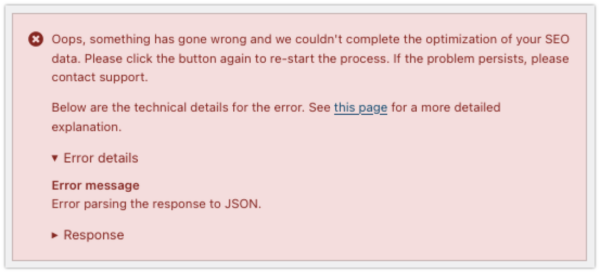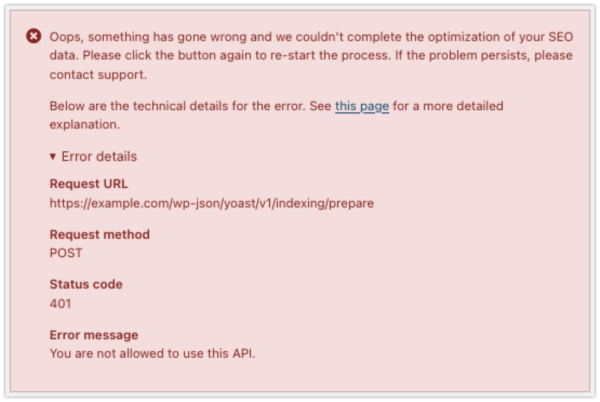We couldn’t complete the optimization of your SEO data: A technical guide
To optimize your websites’ SEO data, our plugin keeps a list of relevant data on your site that we can quickly access when needed. We dubbed this data the “indexables“.

Did you know that the indexables use the data they gather about your site to help you optimize it better? Check out the SEO workouts and learn how you can use the indexables technology to keep your site easy to navigate and your content easy to find!
Normally, data gets added to the indexables as soon as you create or update a post. But, when you newly install our plugin, or when some data doesn’t get indexed for some reason, we include the option to kickstart the creation of indexables with the SEO data optimization feature.If this process fails, you’ll get an error saying: “Oops, something has gone wrong and we couldn’t complete the optimization of your SEO data.” This article will describe the most common causes for this error that we see in our support inbox.
Table of contents
Why did I get an error for the SEO data optimization?
Kickstarting the creation of our indexables can be a taxing process. The larger the site, the longer this process may take. Due to the nature of this process, there are, unfortunately, some ways in which this process may fail. When this happens, for the longest time, we have shown a default error message. Unfortunately, this didn’t help you or our support team to get to the problem. Starting with Yoast 16.9, we now include a technical summary with the error message that may help you figure out what went wrong.

Specific error messages
There may be a specific error message related to SEO data optimization, like the one described below.
Error parsing the response to JSON
This error most likely means that your website had problems while trying to fulfill the request. When you open op the response in the message, you should find the information that your server sent in response to our request. You can use this information to determine what went wrong.
Specific status codes
You may also get a status code in your error message. What does that code mean?

Status code 301 / 302
301 and 302 are status codes that indicate that a request is being redirected somewhere else. Something in your site redirects this request away from the WordPress API endpoint where we need to be. See if disabling any redirection plugins fixes this, or maybe your web server handles this.
Status code 401 / 403
These status codes deal with requests that are blocked or unauthorized. This means that something in or in front of your website is blocking our requests to the WordPress API. We see that some Web Application FireWalls utilize some rules that may block some of these requests. This status code will also show up if you’ve completely disabled the WordPress API.
Status code 500 through 503 and 504
These status codes indicate that something went wrong within your website while processing our optimization. You should be able to get more information from your websites’ PHP error logs. 504 indicates a timeout. This may indicate there’s an endless loop happening or a lot of data is being processed, which can’t finish before your server terminates the process.
Known cases that will give an SEO data optimization error
Whenever we have investigated an error with a cause that happens to multiple users, we will write a summary in this section to help you determine the next steps to take.
Case 1: Web Application Firewalls (WAF) blocking (part of) the endpoint
We have seen users unable to use the SEO optimization tool because of a WAF blocking (part of) the REST requests that our plugin needs to do. You will see the status code of 401 / 403 with a message that you can’t use that endpoint. One specific WAF that blocks part of our requests that we know of is Comodo. So if you experience these issues and use that WAF, you can check if the issue is resolved when (temporarily) disabling the WAF.
Need additional help?
If you could not find the cause of the error with this article, you can always enlist the help of others. Are you are a Premium customer? Then you can contact our support team. If you are a free user, you can ask your question on the free support forums. Whichever method you use, always provide as many details as possible, including the error details.


